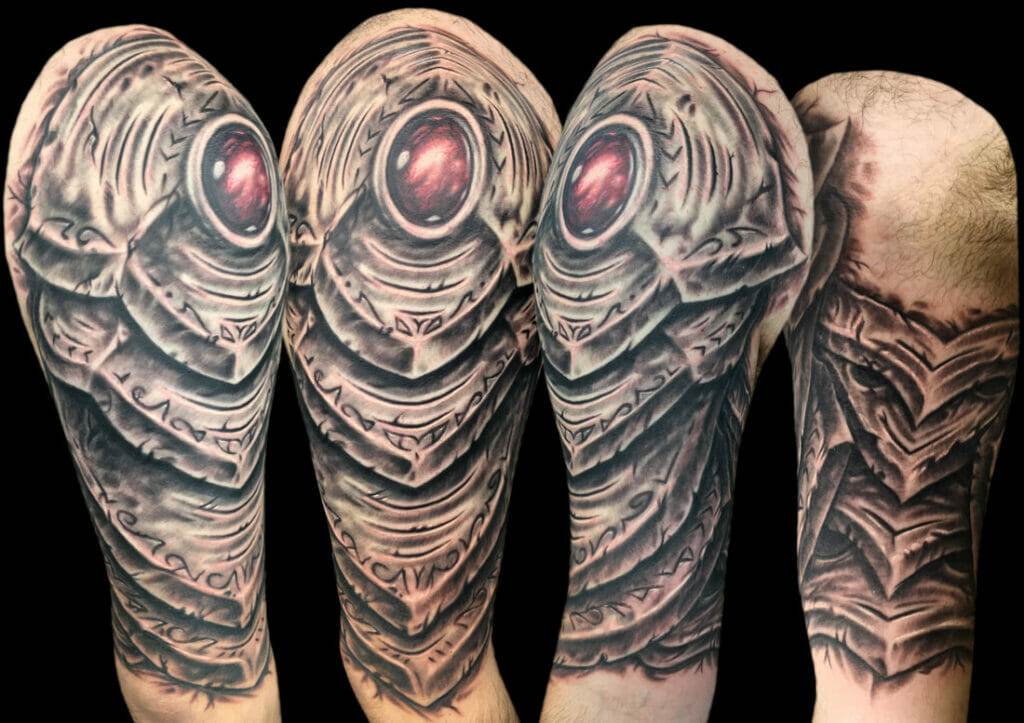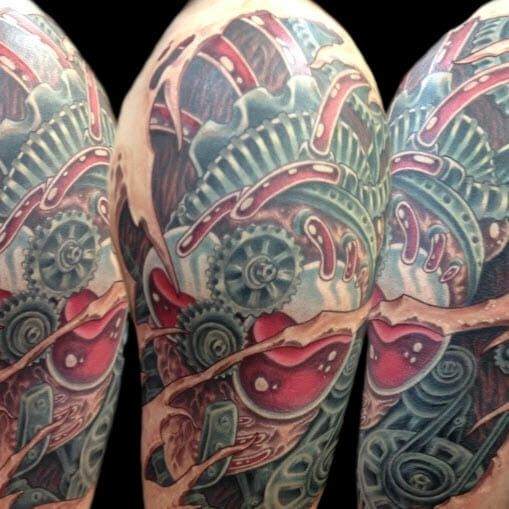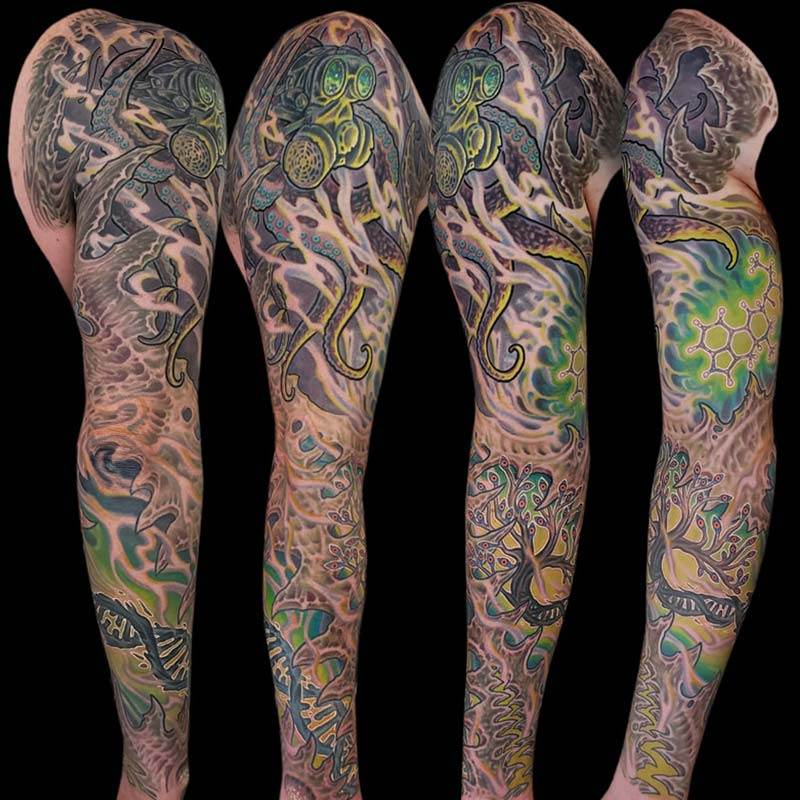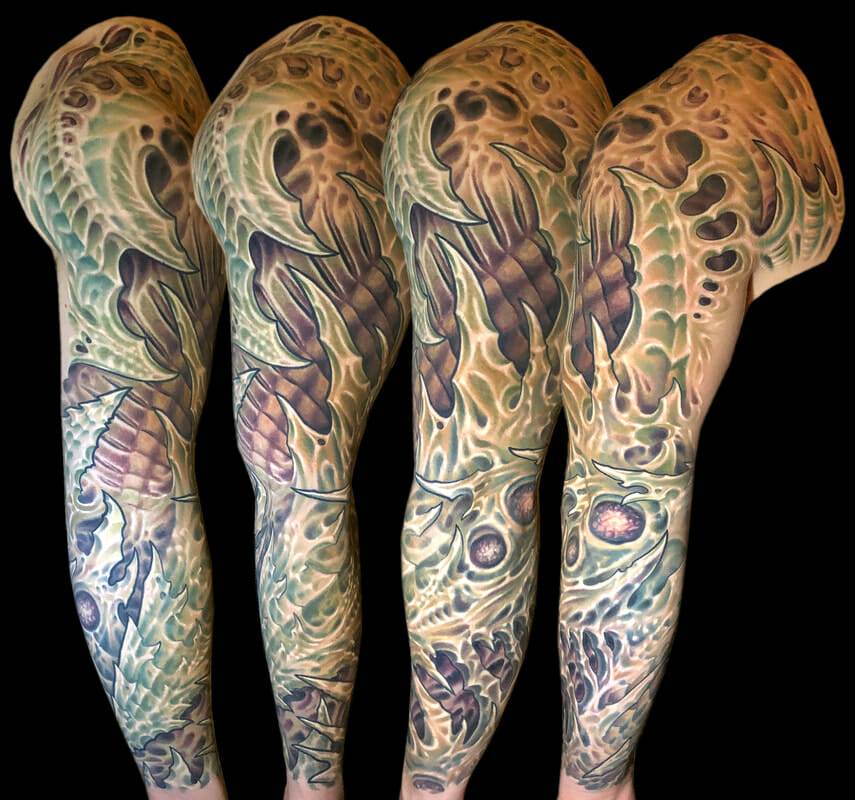Biomechanical tattoos are a unique and captivating form of body art that combines elements of machinery, robotics, and organic forms. These tattoos create the illusion that the skin is peeled back to reveal a complex network of gears, wires, and other mechanical components underneath. Biomechanical tattoos have gained popularity in recent years due to their intricate designs and the way they merge the worlds of technology and biology. In this article, we will explore the history, rise, and future of biomechanical tattoos, as well as their impact on body modification culture, artistry, symbolism, cultural appropriation, and gender.
The History of Biomechanical Tattoos
The origins of biomechanical tattoos can be traced back to the work of Swiss artist H.R. Giger. Giger is best known for his design work on the film “Alien,” where he created the iconic xenomorph creature. His dark and surreal style heavily influenced the genre of biomechanical tattoos. Giger’s art often depicted a fusion of organic and mechanical elements, with intricate details and a sense of otherworldliness.
Over time, biomechanical tattoos have evolved and become more complex. Artists have pushed the boundaries of what is possible with this style, incorporating more realistic textures and three-dimensional effects. The designs have become more intricate and detailed, with artists using shading techniques to create depth and dimension. Today, biomechanical tattoos are often seen as a form of body art that showcases both the artist’s skill and the wearer’s appreciation for technology and innovation.
The Rise of Biomechanical Tattoos
In recent years, biomechanical tattoos have experienced a surge in popularity within the tattoo industry. This rise can be attributed to several factors. Firstly, advancements in tattooing technology have allowed artists to create more intricate and detailed designs. With the use of specialized tattoo machines and needles, artists can achieve a level of precision that was not possible in the past.
Additionally, the influence of celebrities has played a significant role in the rise of biomechanical tattoos. Many well-known figures, such as musicians, actors, and athletes, have embraced this style and showcased their own biomechanical tattoos. This exposure has helped to popularize the trend and make it more mainstream.
Biomechanical Tattoos and Technology
Biomechanical tattoos are a perfect example of the intersection between art and science. The use of technology in creating these tattoos is essential to achieving the desired effect. Artists often utilize digital tools, such as computer software and graphic tablets, to design and refine their biomechanical tattoo concepts. These tools allow for precise detailing and the ability to experiment with different elements before committing to a final design.
In addition to digital tools, artists also rely on specialized tattoo machines and needles to create biomechanical tattoos. These machines are designed to provide maximum control and precision, allowing artists to create intricate lines and shading. The use of different needle configurations also helps to achieve different textures and effects, such as the appearance of metal or circuitry.
The Future of Biomechanical Tattoos
As technology continues to advance, so too will the possibilities for biomechanical tattoos. Innovations such as 3D printing and augmented reality have the potential to revolutionize the field. Imagine being able to see your biomechanical tattoo come to life through a smartphone app or having the ability to change its appearance at will.
Furthermore, advancements in tattoo ink technology may allow for even more realistic and dynamic biomechanical tattoos. Imagine tattoos that can change color or glow in response to certain stimuli or tattoos that can interact with other devices or technologies.
Biomechanical Tattoos and Body Modification

Biomechanical tattoos have had a significant impact on body modification culture. They have become a popular choice for those seeking to express their love for technology and innovation. These tattoos often serve as a form of self-expression and can be seen as a way to merge the human body with machinery.
However, like any form of body modification, there are both pros and cons to getting a biomechanical tattoo. On the positive side, these tattoos can be visually striking and unique, allowing individuals to showcase their creativity and individuality. They can also serve as a conversation starter and a way to connect with others who share similar interests.
On the negative side, biomechanical tattoos are often complex and require a skilled artist to execute properly. This means that finding a reputable and talented tattoo artist may be more challenging, especially in areas where this style is less common. Additionally, the intricate nature of these tattoos means that they may require more time and sessions to complete, which can be costly.
The Artistry of Biomechanical Tattoos
Creating a biomechanical tattoo requires a high level of skill and talent. Artists must have a deep understanding of anatomy, mechanics, and perspective to create the illusion of machinery beneath the skin. They must also possess excellent shading and blending techniques to achieve realistic textures and depth.
There are several techniques and styles used in creating biomechanical tattoos. Some artists prefer a more realistic approach, using shading and highlighting to create the illusion of depth and dimension. Others may take a more abstract or surrealistic approach, incorporating elements of fantasy or science fiction into their designs.
Regardless of the style, biomechanical tattoos require meticulous attention to detail. Artists must carefully plan out the placement and composition of each element to ensure that the final design is visually balanced and cohesive.
Biomechanical Tattoos and Symbolism
Like any form of body art, biomechanical tattoos can hold personal meaning for the wearer. The symbolism behind these tattoos can vary depending on the individual and their interpretation. However, there are some common themes and meanings associated with biomechanical tattoos.
One of the main themes is the fusion of man and machine. Biomechanical tattoos often represent the idea of humans becoming one with technology or embracing the merging of biology and mechanics. They can symbolize a fascination with innovation, progress, and the potential for human enhancement.
Another common theme is the exploration of the human condition. Biomechanical tattoos can serve as a reminder of our mortality and the fragility of our bodies. They can also represent a desire to transcend our physical limitations and explore new possibilities.
Biomechanical Tattoos and Cultural Appropriation
As with any form of art or cultural expression, there are issues and controversies surrounding cultural appropriation in biomechanical tattoos. Cultural appropriation refers to the adoption or use of elements from another culture without understanding or respecting their cultural significance.
In the case of biomechanical tattoos, some argue that this style appropriates elements from science fiction and cyberpunk cultures without fully understanding their origins or meaning. Others argue that biomechanical tattoos are a form of self-expression and should not be limited by cultural boundaries.
It is important to approach biomechanical tattoos with respect and understanding. If you are considering getting a biomechanical tattoo, take the time to research the origins and meaning behind this style. Consult with a knowledgeable tattoo artist who can guide you in creating a design that is both visually striking and culturally sensitive.

Biomechanical Tattoos and Gender
Biomechanical tattoos have played a role in breaking stereotypes and taboos surrounding gender and tattoos. Traditionally, tattoos have been associated with masculinity, while women who had tattoos were often seen as rebellious or deviant. However, in recent years, there has been a shift in societal attitudes towards tattoos, with more women embracing body art as a form of self-expression.
Biomechanical tattoos, with their intricate and detailed designs, have become a popular choice for both men and women. They offer a way to challenge traditional gender norms and showcase individuality and creativity. Biomechanical tattoos can be seen as a way to reclaim the body and challenge societal expectations.
Biomechanical tattoos have captivated the imaginations of many with their intricate designs and fusion of technology and biology. From their origins in the work of H.R. Giger to their rise in popularity and the use of technology in their creation, biomechanical tattoos have become a significant trend in the tattoo industry.
As technology continues to advance, the possibilities for biomechanical tattoos are endless. Innovations such as 3D printing and augmented reality have the potential to revolutionize the field, allowing for even more realistic and dynamic designs.
Biomechanical tattoos have also had an impact on body modification culture, artistry, symbolism, cultural appropriation, and gender. They have become a popular choice for those seeking to express their love for technology and innovation, while also challenging traditional gender norms.
In conclusion, biomechanical tattoos are a fascinating form of body art that continues to evolve and push the boundaries of what is possible. Whether you appreciate them for their artistry, symbolism, or cultural significance, there is no denying the enduring appeal of biomechanical tattoos.



